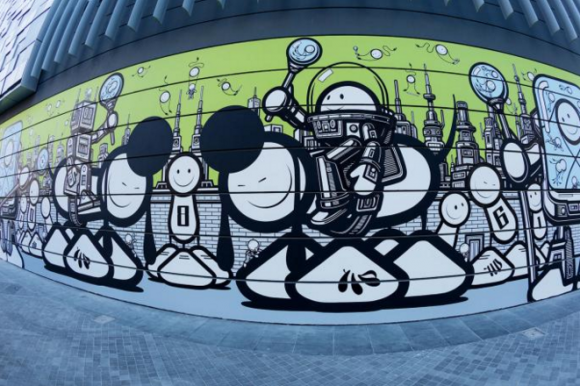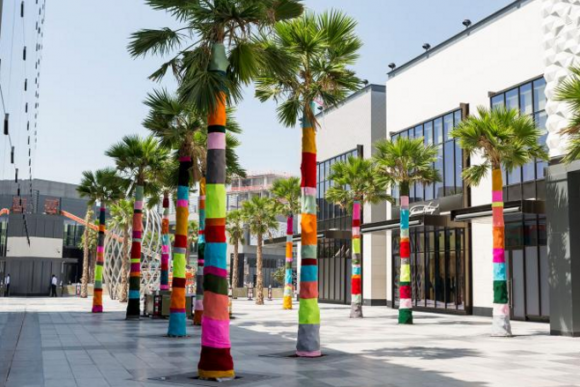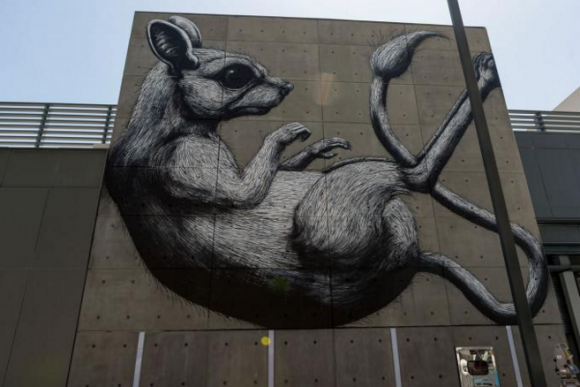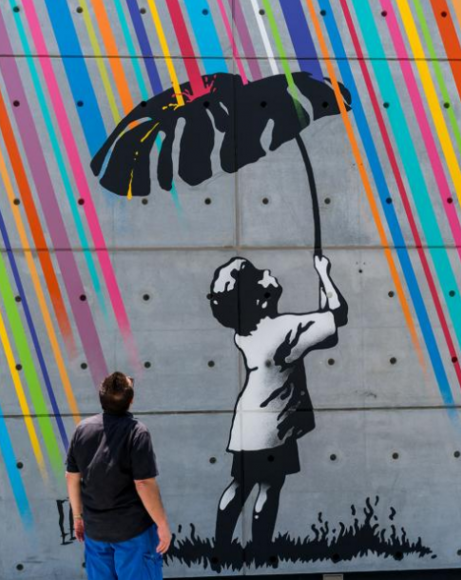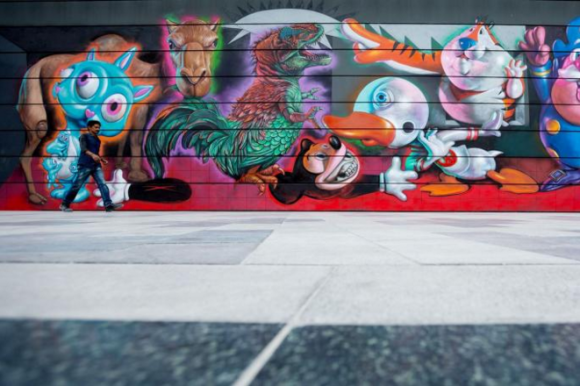To be honest, the thought of going to Dubai to report on the arrival of street art in the Middle East felt like something to be avoided. So I tried to get out of it. I knew little about Dubai — beyond the fact that it is a notorious shopping destination with flexible taxes. And I have nothing against street art. But putting the two together felt like cultural flimflam. There are many places where street art belongs and where it has a history — Paris, New York, London, Barcelona — but Dubai isn’t one of them. Or so I feared.
But the fact that 15 notable international street artists had been invited to contemporary Arabia to express themselves on the duty-free walls of Dubai demanded some investigation. Can an artistic tradition really be bought so easily? So off I jetted into the sun and the sand, where, it turned out, reality really was something that could be created from scratch.
I had been reluctant for various reasons. An important one was that art has a problematic presence in the Islamic world. If you read the Koran, you will see that it contains no specific instruction to avoid art. Indeed, Muhammad himself is said to have protected images of Jesus and Mary that he found inside the ancient Kaaba, in Mecca. But that was then. In more recent times, a powerful aniconism has taken hold of the Middle Eastern mind. The blowing up of the Bamiyan Buddhas by the Taliban was merely the most barbarous display of a mistrust of images that has become an insanity in some contemporary corners of Islam.
A bigger reason for my reluctance to travel to Dubai, however, was the concern I felt for street art’s integrity. Its soul. Yes, at its worst, it is nothing more than the idiotic spraying of your name on bits of the city that deserve better. But that’s at its worst. At its best, it is the most energetically responsible art of our times — an address to the world by a generation of artistic naysayers with fierce opinions about the way we live. While most contemporary art is reluctant to lift its eyes from its own navel — enough with the identity politics, pur-leeze! — street art looks about itself, and complains at what it sees. What the hell, then, was it doing in the Middle East’s most successful shopping zone?
And it wasn’t alone. In Abu Dhabi, the Louvre is about to open an oriental annex, and I hear the Guggenheim is also planning an outpost. In Doha, the Qataris are packing their capital with new museums. Art, it seems, is becoming a brand leader for the Gulf states. But can you buy culture?
Dubai is silver and brown. The brown is the colour of the sand blowing in from the desert, creating a layer of sepia above the rooflines. The silver is the colour of all the chrome, all the glass, all the mirrors, all the spouting water with which this impossible city is seeking to disguise its desert origins.
The Emirates Terminal at the airport is so heavily silvered, it seems hardly to exist. Everywhere you look, your reflection stares back at you from ceilings, columns, walls, fountains and the silvery path that leads you, Wizard of Oz-style, through the duty-free shopping.
We pass into town through a canyon of silver towers, each trying to look taller than the one next to it, like classmates in a school photo. I gaze keenly at their shiny walls. Not one of them has a scratch on it, let alone a dollop of paint or a quickly scrawled name. Such actions are illegal here.
Trumping all the other towers in the height stakes is the miraculous Burj Khalifa, the world’s tallest building, which soars half a mile into the sky. Shapewise, it’s a medieval church spire, stick-thin and pointy. The way it sits on every horizon is churchy, too. The point of a church spire was to call you in from every distance. In Europe, they can’t do that any more because taller buildings have obscured them. But in Dubai, in the desert, the effect lives on.
A couple of days later, I finally got to go to the top of the Burj Khalifa in the company of D*Face, the celebrated London street artist, and his painting buddy, Boots. At the Burj, you can actually see two sunsets on one visit — the first from ground level, the second from the summit. But what really seemed to impress the visiting spray-canners, who have been paid to come here to ply their trade, was the sight of all the virgin rooftops laid out below in an Arabic check. Looking across at D*Face at the top of the Burj Khalifa, I caught him sniffing out the territory like an urban fox. All those empty canvases. Waiting.
I’m getting ahead of myself, though. You’ll want to know how I finally found some street art in the land of no street art. Well, that’s where the Dubai development company Meraas comes in. In its official fact sheet, Meraas describes itself as “a Dubai-based holding company which has launched several projects in the property, hospitality, retail, leisure and entertainment, food and beverages, healthcare, residential and technology sectors”. Now, I know nothing about international finance, but even I can tell that this is an octopus with an unusual number of tentacles.
Just a paper-aeroplane glide away from the Burj Khalifa, on the edge of the Dubai tower belt, Meraas is building a custom-designed modern neighbourhood called City Walk — “a city within a city”. It differs from other custom-designed modern neighbourhoods out of which modern Dubai has been created in two ways. The first is that it is strikingly low-rise. Where most of modern Dubai sprawls upwards into the sky, City Walk sprawls sideways, into the sand.
The second difference is that its walls are covered in loud, scratchy, surprisingly naughty murals. The first one I see is gigantic — a girl peeling an orange, painted onto the side of a six-storey building on the newly constructed approaches to City Walk. Judging by her clothes, which are severe and domestic, the giant kitchen girl is more used to peeling potatoes than oranges. But hey, this is the Middle East, right?
She sits on a beautiful oriental carpet that seems too posh for the circumstances. And as she hunches over her work, her glum mood seems also to belong to another era: the era of the Old Masters. Actually, I have seen her kind before in moralistic Dutch kitchen scenes of the 17th century, where the kitchen maid’s lot in life is to stare into the distance and lament her domestic imprisonment. Surely Etam Cru, a sarky Polish duo who specialise in end walls, couldn’t have had those kinds of meanings in mind in their contribution to City Walk? They wouldn’t have had the nerve, would they?
This city within a city has shops, cinemas, museums, a square, a mosque, tons of expensive housing, spouting fountains at every important civic junction, and, now, a crazy assortment of pictures sprayed onto its walls and its interstitial spaces. See that rat on the side of a dustbin? That was done by the pioneering stencil artist Blek le Rat, who hails from Paris. See how the palm trees in City Walk are candy-coloured and striped? That’s because Magda Sayeg, the inventor of “yarn bombing”, has given them woolly jumpers to wear, of the sort your granny used to knit.
All this is the brainchild of Edris Alrafi, chief leisure and entertainment officer at Meraas, who comes striding out to greet me dressed in the crown-to-toe white of the traditional Emirati Bedouin. A firm grasp of the hand, no pause for small talk, and he’s off, laying out in detail the unreal new reality that is City Walk.
Was I familiar with the developmental consequences of the eight-four split? No, Edris, I am not. So he starts power-talking me through it in his crisply technical English.
The four months of the summer from May to August are too hot for people to go out. So they stay indoors in the air conditioning and leave their shopping to the eight months when temperatures outside are bearable. This eight-four divide, which has governed development in Dubai for 50 years, is what City Walk is taking on.
Did I also know that Emiratis have the highest vitamin D deficiency in the world? No, Edris, I didn’t know that, either. I thought vitamin D deficiency was something people got in Finland because of the endless winter?
Not as badly as you get it in Dubai, it appears. Here, seasonal affective disorder is caused by too much sun. No one walks the streets. Everyone stays indoors. Everyone drives. Women cover themselves from head to toe in black robes that block the solar rays. Across the Middle East, the power of the sun has triggered an epidemic of SADness.
The aim here, therefore, he explains, getting excited, is to get people out on the streets again. Out of the elevators, out of the towers, out of the underground shopping malls. At City Walk, they are trying to create a European-style cafe society that sits on the pavement and sips coffee. And if you destroy the eight-four divide, shopping can become a year-round experience.
To achieve this, the company have gone to remarkable lengths. An entire street in the pedestrian precinct has been made to look like London. There’s a red postbox on the corner and a red telephone box by the Armani outlet. The shops are half-timbered. And the name, Walk Lane, has been spelt out on what looks like a typical London street sign — “Walk Lane, D1”. Even Blek’s rats, sprayed onto the local dustbins, look archetypally Londony. The aim is to conjure up “the charismatic urban vibe of a high street”. So that, I guess, is where the street art comes in.
As soon as you enter the shopping zone you are greeted by a grimacing blue face, sprayed there by D*Face, advising you to “Shop Till You … Drop!!!” A couple of walls later, one of D*Face’s pretty cartoon women finds herself being obliterated by a giant roller. “Nothing Lasts Forever”, she speech-bubbles perkily.
D*Face, whose real name is Richard, and who is up on a cherry picker in the fierce heat, bravely finishing off his disappearing woman, used to be a graphic designer with a respectable job. But he got fed up with pleasing his clients and decided to start pleasing himself — by sneaking out into the streets and painting naughty things on them.
The monstrous blue face advising us to Shop Till You Drop isn’t being very complimentary about the City Walk shopping experience, is it, D*Face? No, he chuckles. It isn’t. As for the woman being obliterated by a paint roller, she stands for the way everything in Dubai goes up quickly, then comes down quickly.
I wonder to myself if Edris has noticed that the street artists he has brought over to create his “charismatic urban vibe” appear, er, less than positive about the City Walk concept? He doesn’t seem to have, so I decide not to mention it just yet. Instead, we stroll deeper into his new urban reality, where I continue to be gobsmacked by the details.
Walking distances between the car parks and the shops have been calculated to the centimetre. The streets themselves are geometrically air-conditioned by locational blasts from the shop interiors and a system of awnings and sprinklers that can bring down the temperature by three to four degrees.
Because children are the location-setters in the modern shopping experience — they tell you where they want to go and cry if you don’t take them — City Walk is packed with carefully positioned child-friendly zones. At the heart of the shopping precinct, at Hub Zero, is the first video-game theme park in the Middle East. At Geek Nation, around the corner, you can buy a Spider-Man costume and dream of swinging between the towers. Unless you’d rather fly, in which case you need an Iron Man suit.
On the way to the Green Planet, I notice that an artist who calls himself Roa, who’s from Belgium, has painted giant rodents on the approaching walls. Street artists love rats — probably because they see themselves as human versions of them. But Roa’s rats are different. Not just because they are elephant-sized, but because they look as if they are trapped, like the bodies of those East End gangsters you hear about, interred in the concrete of the North Circular.
It turns out Roa always paints giant animals. Wherever he goes, he researches the local animal population and records it. These particular rodents are desert rats, of the kind you find in the Arabian sand. Or rather, used to find, before Dubai was built over them. Now that you mention it, they do look especially glum and haunted.
Later that evening, I ask Edris if he knows about street art’s reputation for edginess and illegality. Yes, he does. But it doesn’t worry him in the slightest.
“You know we are new. We don’t have the 10,000-year history that London has. When I look at street art, I see something new and beautiful. I don’t see the past.
“As an individual, I don’t follow fine art or contemporary art. I don’t go to galleries, because I feel they are closed places for very posh people. So when I used to walk in Europe, I loved it when I saw very creative art on a piece of wall or on a building. Why don’t you make that beautiful piece of art accessible to everybody?”
So, yes, he knows that 5% of street art may be doing something controversial or bad. But does that mean you have to avoid it altogether? “Some people misuse the internet. But you’re not going to close down the internet, are you?”
Over the next few days, I ask various people what the penalty would be if anyone was caught spraying something illegally onto one of the silver towers? The question provokes a roll of the eyes. No one knows for sure. But it would be something ghastly. That’s why the silver towers stay so silver. Most of the Dubai population are immigrant workers; any trouble with the police can lead to deportation, hence levels of crime are very low.
The murals at City Walk are definitely going against Dubai’s natural grain. Or rather, they would be if Dubai had a natural grain. But as the whole place is a fabrication, a manmade mirage in the desert, there is no overwhelming reason why street art shouldn’t flourish here, just as all the other impossible imports have flourished.
At the top of the Burj Khalifa, I ask D*Face if he was told what he could paint in City Walk. No, he wasn’t. The only subjects he was warned about were religion and nudity. Everything else was on.
Back at the shopping centre, the most eye-catching of the new murals is a huge frieze of cartoonish characters painted by Ron English. It features a blue goggle-eyed monster surrounded by baby goggle-eyed monsters, with Mickey Mouse, Donald Duck and Tony the Kellogg’s tiger. They’re funny, and seemingly cute. Until you notice the Tyrannosaurus rex rampaging among them. And the sullen camel at the back.
English calls his murals “propaganda”. Since he started spraying them in the 1980s, he has used public art to make us aware of the dark commercial forces at work in our world. Especially in the food business. Tony the Tiger has popped up often in English’s Cereal Killer series, warning of the sugar content in kids’ breakfasts. So has Captain Cornstarch, the fat, one-legged pirate who waves his arms around on the right of the mural. Thus, amazingly, among the “tree-lined walkways and energised water features, intermingled with alfresco cafes and restaurants” of Dubai, there is a fierce attack on those who peddle food poison to shoppers.
Something else about English’s mural bothered me. Every time I walked past, I felt compelled to stop for another inspection. Finally, it dawned on me. The position of the figures, their poses, the distribution of spaces, was familiar. The camel mural was a version of the most celebrated antiwar image of the 20th century — Picasso’s Guernica.
Where Picasso shows a weeping mother and her baby on the left, English has his blue goggle-eyed monster mama. Where Picasso has the fallen warrior, English has a prostrate Mickey Mouse. Instead of the woman on the right, bellowing with terror, there’s Captain Cornstarch waving his arms about. And where Picasso painted a dumb bull to locate his terror in bullfighting Spain, English has stuck a camel of the kind you sometimes see plodding across the concrete of the new Arabia.
I came to Dubai fearing that street art would lose its soul by coming here. I left Dubai 100% certain that it had not.



